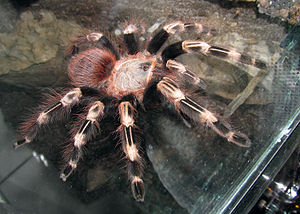Nhandu
| Nhandu | ||||||||||||
|---|---|---|---|---|---|---|---|---|---|---|---|---|

|
||||||||||||
| Systematics | ||||||||||||
|
||||||||||||
| Scientific name | ||||||||||||
| Nhandu | ||||||||||||
| Lucas , 1983 |
Nhandu is a genus of tarantulas that was established in 1983 by the Brazilian arachnologist Sylvia Lucas of the Butantan Institute . The genus contains five species and belongs to the subfamily of theraphosinae . The animals are mainly native to Brazil . One species ( Nhandu carapoensis ) also occurs in Paraguay . Some of these species are sometimes kept in terrariums.
features
The spiders have a specially shaped sperm library . They have no stridulation organs and have extensions of the scopula on the metatarses, which extend to the base of the metatarses of the first and second pair of legs. In the third pair of legs they come to four fifths of the length of the metatarsus and in the rear pair of legs to a third. The males have only a small embolus in the bulbs .
distribution
The animals of this genus occur in the Brazilian states of Mato Grosso and Tocantins as well as in the neighboring state of Paraguay. The main distribution area of Nhandu tripepii was flooded by a reservoir project . The animals have become rare as a result. Individual specimens were rescued from floating debris by the employees of the Butantan Institute.
behavior
The species are among the tarantulas that live on the ground. In addition, they are counted among the so-called " bombardier spiders ", as they can shed their stinging hairs on the opisthosoma with their hind legs and hurl them at the supposed attacker. Not much has been researched into the exact way animals live in nature.
The animals kept in terrariums show a high level of digging activity. They also spin a lot and line their living tubes with silk. If they are disturbed, they often use their stinging hair to defend themselves.
Systematics
Sylvia Lucas described the genus in 1983 on the basis of the new species Nhandu carapoensis ( holotype species). It has strong similarities with the Sericopelma described by Anton Ausserer in 1875 . It was therefore discussed among arachnologists whether this new genus is not a synonym. A cladistic analysis by Fernando Pérez-Miles in 1996 showed that the two genres differ. In the end, most authors followed this interpretation. The genus Brazilopelma , described by Günter Schmidt in 1998 , is now viewed as a synonym of Nhandu .
The World Spider Catalog currently lists five species for the genus Nhandu . (As of April 2016)
- Nhandu carapoensis Lucas , 1983
- Nhandu cerradensis Bertani , 2001
- Nhandu chromatus Schmidt , 2004
- Nhandu coloratovillosus ( Schmidt , 1998)
- Nhandu tripepii ( Dresco , 1984)
Web links
Nhandu in the World Spider Catalog
Individual evidence
- ↑ a b c R. Bertani: Revision, cladistic analysis, and zoogeography of Vitalius, Nhandu, and Proshapalopus; with notes on other theraphosine genera (Araneae, Theraphosidae) . Arq. Zool., S. Paulo, 2001, 36: 265-356.
- ↑ a b Peter Klaas: tarantulas: origin, care, species . Eugen Ulmer Verlag , Stuttgart 2003/2007, ISBN 978-3-8001-4660-4 , pp. 109-110
- ↑ a b c Natural History Museum of the Burgergemeinde Bern: World Spider Catalog Version 17.0 - Nhandu . Retrieved April 25, 2016.

